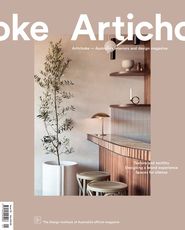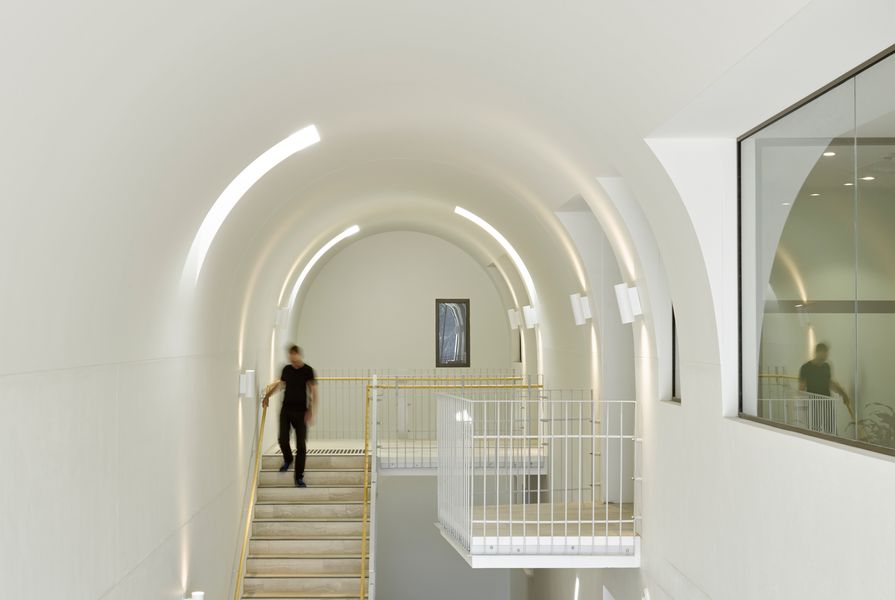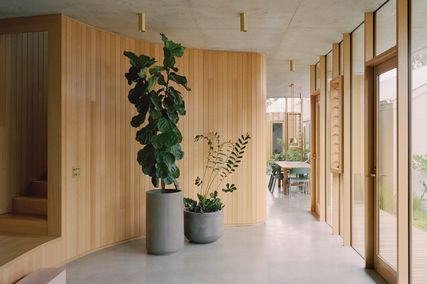There are few commercial projects that better encapsulate the power of a “big idea” than Byres Street, an office building in Brisbane designed by Cavill Architects in association with Hogg and Lamb. The concept manifests physically in the form of a remarkable, four-storey barrel-vaulted atrium enclosing a monumental staircase that brings a sense of civic scale and generosity to an otherwise unassuming commercial development. Beyond the grand gesture, a deeper philosophical approach is it play. It speaks of the value of embedding a sense of community in the workplace.
The Byres Street building is a striking anomaly in a Brisbane neighbourhood defined by light industry and commercial warehouse buildings. Approximately half a kilometre south of Byres Street, the Gasworks precinct has evolved to become a thriving, highly-serviced centre but despite this, the Byres Street site remains disconnected from any immediate amenity. “What came out of that was the idea that perhaps there should be a dedicated space in the building that was semi-public in nature,” architect Sandy Cavill says. “Staff could step out of the workplace and rub shoulders with neighbours and be with the landscape. It could be a programmed space or an entirely informal space.”
The scattering of light wells registers changing sunlight to stunning effect.
Image: Christopher Frederick Jones
The idea translated into the semi-public gallery ascending the northern edge of the plan, feeding flexible commercial office spaces from three consecutive landing points. Enlivened by landscape, sunlight and apertures to the sky, the space is likened to a friendly streetscape where chance encounter generates impromptu conversation and strengthens a sense of community. Rooms arranged along this atrium edge benefit from participation in t he visual spectacle of movement, pause and exchange. The scattering of light wells, washing the walls and ceilings with light, registers changing sunlight and weather patterns to stunning effect.
The architects held tightly to this potent concept, offering almost a quarter of the commercial office space up for the atrium experience – or so it seemed. Indeed, to preserve the sanctity of the section, the plan had to work very hard. “The building only has one fire-isolated staircase,” Cavill says. “We were able to rely on the atrium staircase as a supplementary escape route so there were some efficiencies to be gained by its inclusion.” Further offsets came from sliding kitchen and bathroom areas into the atrium volume and also drawing balconies and meeting settings into this same space.
Balancing spatial efficiencies with moments of spatial generosity was only part of the game. For a speculative project by a developer entering into this market for the first time, it was critical that the development offered something unique in a competitive market. Therein lies the value of creating an experience for the tenant and a memorable encounter for the visitor. “The client recognized that in doing something like this, there would be much less risk of vacancy and that, in itself, has value – it reduces stress and maintenance and gives the enterprise longevity,” Cavill says.
The atrium is an interactive space that acts as a sanctuary for its occupants.
Image: Christopher Frederick Jones
That the grand gesture is so legible from the street gives further weight to the idea. The sweeping barrel vault extends beyond the glazing line to the very edge of the facade. The arched window creates a magnificent oculus through which occupants and visitors view the street outside and passers,by absorb the animation of the interior. The exterior demarcation of vertical arch versus layered floor plate announces the clear division of public and private zones, interaction versus industry. In a building accommodating multiple independent tenancies, this public gallery represents a touchstone for smart, inclusive businesses.
As our working communities become more agile, disparate and immersed in a digital world, the need for human connection and exchange becomes increasingly important. As we spend more time detached from home communities, the need to embrace the working community becomes greater. Finding ways to fulfil these deeper human needs of inclusion and connection helps to support the spiritual needs of contemporary work patterns. “I think, in this time, it seems really obvious that tenants of progressive businesses are looking for spaces that do offer their staff more, so perhaps making big moves is really the bare minimum,” Cavill says.
Products and materials
- Walls and ceilings
- Vaulted plasterboard sheet from Rondo. Walls painted in Dulux ‘Whisper White.’
- Flooring
- Travertine pavers and stone tiles from CDK Stone. Neoflex NTRL rubber flooring from Rephouse.
- Other
- Custom-designed Tasmanian oak handrail on steel brackets.
Credits
- Project
- Byres Street
- Design practice
- Cavill Architects
Brisbane, Qld, Australia
- Project Team
- Cavill Architects: Sandy Cavill, Scott Wilson, Hogg and Lamb: Michael Hogg, Greg Lamb
- Design practice
- Hogg and Lamb
Brisbane, Qld, Australia
- Consultants
-
Builder and project manager
Limitless Property
Civil engineer Naxos
Hydraulic engineer Chilton Woodward & Associates
Landscaping Seed Landscape Design
Mechanical and electrical engineer Cushway Blackford Consulting Engineers
Structural engineer Westera Partners
Traffic engineer TTM Consulting
- Aboriginal Nation
- Built on the land of the Turrbal people.
- Site Details
-
Location
Brisbane,
NT,
Australia
Site type Urban
- Project Details
-
Status
Built
Completion date 2019
Design, documentation 10 months
Construction 12 months
Category Commercial, Interiors
Type Workplace
Source

Project
Published online: 3 Sep 2020
Words:
Michelle Bailey
Images:
Christopher Frederick Jones
Issue
Artichoke, March 2020
























